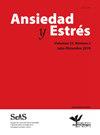Presence and predictors of suicide ideation in a clinical outpatient context
IF 0.5
Q4 PSYCHOLOGY, CLINICAL
引用次数: 0
Abstract
Background: It is of vital importance to study the risk factors associated with suicidal behaviour. The purpose of this study is to analyse the presence of suicide ideation and related factors in an applied clinical environment. Method: A correlative-predictive study is conducted with a sample of 180 adult patients, 64% women, with an average age of 31.88 (SD = 14.473) at University Psychology Clinic of Complutense University of Madrid (CUP-UCM). Suicide ideation is analysed (measured by Item 9 of the BDI-II), together with its relationship with clinical diagnosis, symptoms of depression, hopelessness and a range of sociodemographic variables. Results: 31.7% of the sample had shown suicide ideation. Significant differences were found depending on: cohabitation unit, symptoms of depression, presence of hopelessness, personal history and being under pharmacological treatment. Living alone is postulated as a stable predictor of suicide ideation (with an OR of 0.403). Together with personal history, symptoms of depression and hopelessness, these factors explain 42.5% of the presence of suicide ideation ( χ 2(13) = 65.056; p < .001; R2 = 0.425). Conclusions: The high prevalence of suicide ideation in the clinical population and the risk factors found, confirm the importance of focusing on this phenomenon, in particular taking into account its presence within different problems beyond the diagnostic label and the significance in certain contextual factors (e.g., living alone).在临床门诊环境自杀意念的存在和预测因素
本文章由计算机程序翻译,如有差异,请以英文原文为准。
求助全文
约1分钟内获得全文
求助全文

 求助内容:
求助内容: 应助结果提醒方式:
应助结果提醒方式:


